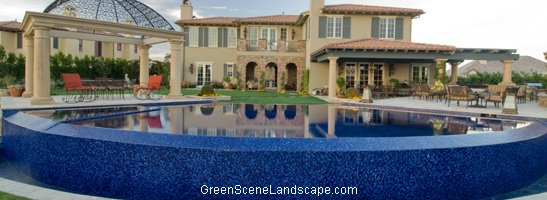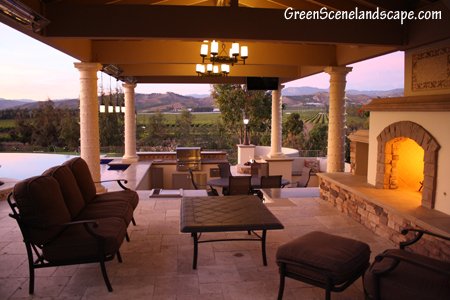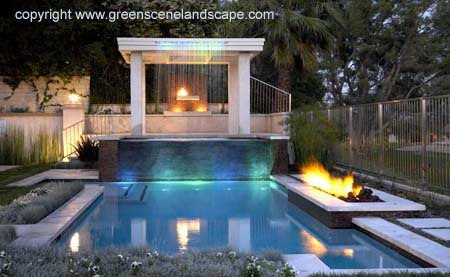Making the Scene
By Scott Cohen

For the past 25 years, “garden artisan” Scott Cohen has embraced the challenge of creating beautiful outdoor spaces for mostly upscale residential clients. Starting out his career as a plant expert, over the years Cohen has steadily expanded his repertoire to encompass nearly all of the major elements found in today’s custom exterior settings, a pursuit he explains opens doors, stimulates the mind and most importantly leads to satisfied clients.
Last year at the World of Concrete show in Las Vegas, I was presenting a seminar on fire features when a gentleman in the audience raised his hand and asked me, “What are you? Are you a pool contractor, a landscaper, a mason, a designer, or what?”
Seemed a straightforward enough question, but I was surprisingly caught off guard and wasn’t quite sure how to answer. Truth is, I explained, I’m a little bit of all those things (and for the purpose of that particular class, I was a guy who knew a thing or two about using fire as a design element.)
Afterwards, the exchange made me think of the old phrase, “jack of all trades; master of none” and it suddenly struck me that I don’t buy into that at all. Instead, I believe if you work at it, you can become highly proficient across a spectrum of skills. Certainly there’s nothing at all wrong with specialization, but who said that you couldn’t be good at several things? Why not strive to be a Renaissance man if that’s what you want?
In fact, I believe it is entirely possible to be what I call a “jack of all trades; master of design!”
UP FROM THE GARDEN
Okay, I admit that’s a bold position, so let’s back things up a bit. When you look at the pool and spa industry, everyone working in the trade had to come from somewhere. Perhaps it was the family’s business, or a background in general contracting, or a specialty in masonry, or pool and spa service, or landscape design, or formal architecture. The roads that lead to the backyard are as diverse as the people who travel them.
And what do we call ourselves? Pool guys, watershapers, landscape designers, builders, or environmental artists? To varying degrees, they all roughly mean the same thing; someone who is in the business of creating exterior spaces that generate beauty, pleasure, recreation, gathering places, tranquility, excitement and pride of ownership.
For my part, I like to use the term “garden artisan,” admittedly a somewhat esoteric term, but it works for me in that it literally and figuratively stems entirely from the nature of my own background, which began with plants.
My company, The Green Scene, originally my family’s business, focused mainly on providing fertilizing and weed control for lawns, a product of the post-World War II suburban sprawl that overtook places like southern California. As a kid I would ride my bike to work after school and spend afternoons answering questions over the phone about plants and lawns. Later when I could drive, I bought a pick-up and a lawnmower and worked part time cutting grass and eventually cleaning a few pools. For a kid working part time, I made some darn good money and generally had a great time.
After high school my next big step up came when I landed a job managing the garden department at a local Target store. I learned a great deal more about the taxonomy of plants and how to manage a retail operation. Turned out I was good at it and was quickly promoted to regional manager overseeing 13 stores. I wore a three-piece suit and at age 19 was the youngest executive in the then powerhouse Dayton Hudson Corporation.
At 21, I took that experience back to the family business, this time managing the landscape division. As far back as I can remember I had always loved drawing and playing with Lego blocks, Lincoln Logs or Erector Sets and to this day, design work is the part of the business that I love the most. As a young adult, I wanted to know more about design and art and so whilst I was running the landscape operation and learning about all aspects of the garden, I decided to study ceramics and fine arts at a local college.
To sum it up, in my case, education came mostly by way of applied learning with a good dose of formal training and management experience. More than anything else, however, it was my constant desire to make things that has driven me to create scenes of beauty and luxury for our clients. In many ways, it’s not that different than when I was playing with Legos, except now the blocks are much bigger.
GARDEN ART

In defining the work of the “Garden Artisan” I tell people I will design and build anything and everything in the backyard from the plantings to the decks to fire features. As for water, swimming pools, spas, ponds, fountains and all things aquatic are a major part of that work, but only a part. The same can be said of hardscape, overhead structures, outbuildings, entertainment areas and outdoor kitchens. It all depends on the client, the setting and the budget.
Indeed, each client is different, every property is different and as the design professional its up to me to give the client what they want while at the same time using my background to create garden spaces that are functional and stylistically appropriate for the setting.
Doing so means understanding principles of flow, symmetry, asymmetry, balance, texture, color and style. I look at the backyard as the blank canvas and the work as a form of sculpture. The space, which I refer to as a “garden,” is the art form itself. And when you stop and think about it, gardens can be quite amazing because they are spaces where human experience unfolds. As such the design decisions we make have a major influence on the type of experiences people have.
Hitting that high mark means adapting to the situation at hand. Some lots are on hillsides with expansive views, others shrouded in shade with no views. Some provide ample space to create destinations within the garden and room to wonder, others are very small and you have to make things work in close proximity.
In the same sense, clients are all different. Some have generous budgets where money isn’t a huge concern, while others are on tight shoestrings. Some clients have definite ideas about what they want, while others leave it entirely up to you to decide. Sometimes a husband and wife don’t entirely agree on their priorities and it’s up to you to play psychologist and finesse the situation so everyone winds up happy.
In many ways, what we do is one of the most exciting jobs in the world in the way we get to play with ideas and spend other people’s money being creative. The key to all of it is being able to expand your mind and grow your skills sets so that you come prepared with a range of options that you know can be competently executed each and every time.
MAKING IT WORK
Certainly, all of that is very high-minded and philosophical, but the point of this discussion is that taking on the entire scene as a composition has significant and practical ramifications from an operations and business standpoint, as well stoking our creative fires.
In fact, breaking it down to the most basic level, I’d say the fact that our firm can do so many things is one of the main reasons we’ve survived during the recession. Like just about everyone else in this business, these stubborn economic doldrums have hit our firm pretty hard. Because we work for a mostly affluent clientele and also because we design entire garden spaces, we’ve been pretty nimble in the way we’ve been able to adapt.
For starters, we’ve learned to work consistently with smaller budgets. Even people who still have money are far more likely to be conservative in how they spend it. On top of that, many of our clients are not interested in being nearly as showy as they once were when property values were skyrocketing.
In many cases, this has translated to a different approach to the overall process. These days it’s common for us to design an entire backyard with a variety of features including pools and spas and all of aforementioned elements, but then have the client choose to implement an element or two as a first step, with the idea that the rest of the garden will be built in subsequent phases. In other words, we might design a half-million dollar backyard, but start out building only the outdoor kitchen, or a deck, or a shade structure, leaving the vast majority of the work for later.
Of course, we’d always like to see the entire project go in at once, but given that’s not in the cards for many clients, this piecemeal approach has kept us in the game and hopefully seeded the future with work down the line. Time will tell how well that strategy works, but I can see already that by establishing an expectation for an on-going relationship with the client, we stand a good chance of being first in line when their budgets open up.
Obviously, if you only offer pools or other water features, then you’re not going to have that kind of flexibility.
As of now, of all the things we offer outdoor kitchens have become the most popular backyard amenity. No more than 10 years ago, elaborate outdoor kitchens were relatively unusual, but now they represent the greatest area of growth for our company to the point where almost every project has one and oftentimes, it’s what clients choose to build before anything else. In fact, I’ve found that outdoor kitchens are the features that men and women agree on the most.
In many situations, these kitchen areas have almost all of the appliances found indoors and clients often relate that when it comes to entertaining, the outdoor kitchen is the hub of the social scene. I’ve personally grown to love designing outdoor kitchens precisely because of the enjoyment and functionality the deliver. They’re great when built as part of a comprehensive project and they serve as a wonderful anchor for those clients who need or want to do things piecemeal.
VARIETY IS THE SPICE

In my case, it’s interesting to note (and I have to confess) that I didn’t start out thinking that I’d wind up providing anything and everything in exterior environments. Truth is, my clients basically forced me in this direction.
Being one who always appreciates a challenge, I embraced the expanding nature of the work, and from a business standpoint I more than welcomed the opportunity to make more money by providing broadening sets of options. I also came to appreciate the economies of scale and efficiencies that come with multi-faceted work.
For example, if an outdoor landscape lighting system is part of a project, it’s easy to install the cable runs, conduits, junction boxes and other necessary hardware before you put down hardscape, lawn or other softscape. There’s nothing to it. On the other hand, coming back later on and adding a lighting system to an existing garden where those components haven’t been pre-installed can be significantly more expensive.
The benefits of the comprehensive approach stretch from the most artistic of considerations to the grittiest. There’s simply no downside to working this way.
But here’s where things also get tricky, as well. It’s one thing to want to do it all, it’s quite another to be able to do so. And as cliché as it sounds sometimes, it’s all about education. You have to invest in your base of knowledge before any of this is possible.
COME TOGETHER
These days there’s a tremendous amount of discussion about the nature of trade education verses formal education, practical experience verses book learning and I’m not going to parse those issues here. To my mind, most educational outlets are valuable; if you approach the process with a determination to learn you’ll find something useful in almost any setting, be it a university classroom, trade show seminar, books and digital media, online coursework or some other type of specialized educational program.
Even with some education in a given area there remains the question of how to actually get started in the field. One of the very best ways to expand your abilities is to work with proven, experienced professionals. Although at this stage, our firm does most of our work in house, I’m a big advocate of collaboration between people of complimentary skill sets.
It’s really simple commonsense. Consider that in-ground concrete pools require appropriate structural plans based on the soils conditions. Yet, most of us who design and build pools and are not structural engineers. Instead we collaborate with professionals who understand geology and how to engineer concrete structures.
Moving away from the pool you find the same principle in play with almost every aspect of an outdoor environment. If you’re not a lighting specialist, then establish a working relationship with one, or a carpenter who understands the joinery necessary to build pavilions, pergolas, arbors and other overhead structures. If you’re a pool builder and want to move into the world of plants, why not study the plant kingdom while at the same time working with an experienced landscape designer?
Whether it’s a particular type of designer such as a landscape architect or a subcontractor such as a tile specialist, it’s always critical to choose wisely based on experience and reputation. It’s also equally important to gain a working knowledge of those areas so that you can speak the language and effectively use those elements in design work. After all, it is basically impossible, or at least foolhardy to design something you don’t know how to build or install.
Working in a team setting does require a skill all of its own and if you seek to expand what you offer clients by way of strategic alliances with other professionals, then you do have to learn how to be a good team player. In my case, I’ve struggled somewhat in situations where I wasn’t calling all the shots and have found that the more I can bring under my direct control the more comfortable I am. Even so, I still value the opportunities I have to work with other professionals and have found that in most cases, I’ll come away from that process having learned something useful.
As I mentioned at the outset of this discussion, there’s no set path that leads us directly into this business. We all have to find our own way. I happen to be one who believes that the more one reaches beyond his or her comfort zone and gains additional skills and knowledge, greater and greater opportunities will follow, in good times and even in bad.
And, by the way, lately I’ve become more and more interested in outdoor audio/visual systems. Fortunately I think I know a professional or two who just might be able to help!
